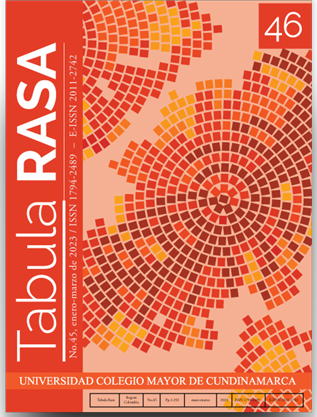Cultivating Ongoingness Through Site-Specific Arts Research and Public Engagement
La investigación artística y la participación pública como estrategias para la resiliencia territorial
Show authors biography
In this article, I consider the contributions of projects in Latin America to the need “to think in the presence of ongoing facts of destruction”, and to imagine and design forms of “ongoingness” amid socioenvironmental challenges and conflicts. I focus on HAWAPI, Ensayos and EnlaceArq, three initiatives that have consolidated a decade of site-specific, practice research that departs from the arts to devise methods that bridge the arts, sciences, and communities to confront socioenvironmental pressures and enduring injustices caused by colonial legacies and continued extractivism. How does site-specific practice research seed and cultivate inter- and transdisciplinary collaborations around pressing socioenvironmental concerns affecting Latin America? How do projects establish critical relationships regarding the circulation of knowledges related to these issues and engage with diverse types of publics? And, insofar as the projects reviewed here often operate on the fringes of academia, what strengths and challenges does this generate for their sustainability over time and their impact on scholarly research, public conversations and the lives of specific communities?
Article visits 212 | PDF visits 35
Downloads
- About (s.f.). Turba Tol Hol-Hol Tol. https://turbatol.org/about-en.html
- Andermann, J. (2018). Tierras en trance: arte y naturaleza después del paisaje. Santiago de Chile: Metales Pesados.
- Barad, K. (2003). Posthumanist Performativity: Towards an Understanding of How Matter Comes to Matter, Signs: Journal of Women in Culture and Society, 28(3), 801-831.
- Bennett, J. (2009). Vibrant Matter: A Political Ecology of Things. Durham: Duke University Press.
- Bishop, C. (2013). Artificial Hells: Participatory Art and the Politics of Spectatorship. London: Verso.
- Blackmore, L. & Gómez, L. (Eds.). (2020). Liquid Ecologies in Latin American and Caribbean Art. London: Routledge.
- Bleichmar, D. (2012). Visible Empire: Botanical Expeditions and Visual Culture in the Hispanic Enlightenment. Chicago: Chicago University Press.
- Borea, G. (2021). Configuring the New Lima Art Scene: An Anthropological Analysis of Contemporary Art in Latin America. Londo: Routledge.
- Coccia, E. (2019). The Life of Plants: A Methaphysics of Mixture. Trad. Dylan J. Montanari. Cambridge: Polity.
- Confluir con ríos. (s.f.). Río Guaire. https://www.rioguaire.org/imagina-charlas-confluir-con-rios
- Jørgensen, D. (2022). Isn’t All Environmental Humanities ‘Environmental Humanities in Practice’? Environmental Humanities, 14(1). https://doi.org/10.1215/22011919-9481561
- Ensayo #1 (s.f.). Ensayos. https://ensayostierradelfuego.net/ensayos/ensayo-1/
- Escobar, A. (2018). Designs for the Pluriverse: Radical Interdependence, Autonomy, and the Making of Worlds. Durham: Duke University Press.
- Gómez-Barris, M. (2017). The Extractive Zone: Social Ecologies and Decolonial Perspectives. Durham: Duke University Press.
- Haraway, D. (2016). Staying with the Trouble: Making Kin in the Chthulucene. Durham: Duke University Press.
- Ingold, T. (2017). The Art of Paying Attention. Presentación magistral en el congreso Art of Research, Helsinki. 29-30 de noviembre. https://www.youtube.com/watch?v=2Mytf4ZSqQs
- Intro (s.f.. Ensayos. https://ensayostierradelfuego.net/ensayos/intro/
- Krenak, A. (2020). Ideas to Postpone the End of the World. Trad. Anthony Doyle. Toronto: Anansi.
- La Palomera (s.f.). https://en.lapalomera.org/
- “Lima Conversations | Localities: HAWAPI. (2016). Camden Arts Centre. 14 de diciembre. https://medium.com/@camdenartscentre/lima-conversations-localities-HAWAPI-751e4b1b27fe
- Lozano, A.M. (2016). Humanos/no humanos: reflexiones sobre el fin de la excepción humana. Bogotá: Fundación Gilberto Alzate Avedaño.
- Manthorne, K. (Ed.) (2015). Traveler Artists: Landscapes of Latin America from the Patricia Phelps de Cisneros Collection. New York: Fundación Cisneros.
- Molina Vargas, H., Marambio, C. & Lykke, N. (2020). Decolonising Mourning: World-Making with the Selk’nam People of Karokynka/Tierra del Fuego. Australian Feminist Studies, 35(135), 186-201. https://doi.org/10.1080/08164649.2020.1774865
- Moore, J. W. (2015). Capitalism in the Web of Life: Ecology and the Accumulation of Capital. London: Verso.
- Morton, T. (2007). Ecology Without Nature: Rethinking Environmental Aesthetics. Cambridge, MA.: Harvard University Press.
- Neimanis, A. (2018). Bodies of Water, Human Rights and the Hydrocommons. Topia. Canadian Journal of Cultural Studies, 21, 161-182. https://doi.org/10.3138/topia.21.161
- Page, K. (2021). Decolonizing Science in Latin American Art. Londo: UCL Press.
- Pratt, M. L. (1991). Arts of the Contact Zone. Profession, 33–40. http://www.jstor.org/stable/25595469
- Puig de la Bellacasa, M. (2012). ‘Nothing comes without its world’: thinking with care. The Sociological Review, 60(2), 197-216. https://doi.org/10.1111/j.1467-954X.2012.02070.x
- Quillinan, S. (Ed.). (2020). HAWAPI 2019 - Máxima Acuña. Lima: HAWAPI.
- Santos, B. S. (Ed.) (2008). Another Knowledge Is Possible: Beyond Northern Epistemologies. New York: Verso Books.
- Silva, E., Sacchini, M., Caradonna, V., Vicente, H., González Casas, L., Carvajal, J., Marin, O. & Amundarain, L. (2015). CABA Cartografía de los barrios de Caracas 1966-2014. Caracas: Fundación Espacio.
- Silva, E. (2021) Los caminos y jardines de La Palomera suspendidos de los techos en La Biennale di Venezia. Prodavinci. 16 de agosto. https://prodavinci.com/los-caminos-y-jardines-de-la-palomera-suspendidos-de-los-techos-en-la-biennale-di-venezia/?platform=hootsuite
- Smith, H. & Dean, R.T. (2009). Practice-led Research, Research-led Practice in the Creative Arts. Edinburg: Edinburgh University.
- Smithson, R. (1996). A Sedimentation of the Mind: Earth Projects (1968). En Jack Flann (Ed.). The Robert Smithon: Collected Writings (pp. 100-113).. Berkeley: University of California Press.
- Solano, J. & Serrano, B. (2021). La fiebre del banano/Banana Craze. Exposición digital y programa público. https://bananacraze.uniandes.edu.co/language/en/
- Stengers, I. (2005). Introductory Notes: An Ecology of Practices. Cultural Studies Review, 11(1): 183-196.
- Tsing, A. (2004). Friction: An Ethnography of Global Connection. Princeton NY: Princeton University Press.




